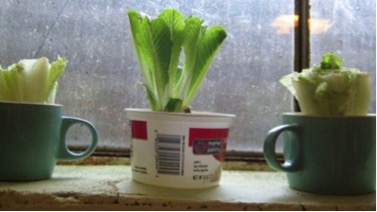Use Your Food Scraps: It's Frugal and They're Tasty!
Are you aware that we waste around 30-40 percent of our food? Carelessness adds up. If you can relate, then this information from one of my favorite sites, Care2, might interest you. Here are some ways we can reuse food scraps to put a dent in the food waste in our kitchens!

Make broth. Save celery tops, onion and garlic skins, carrot peels, and other veggie scraps in a freezer-safe container; also save pulp left over from juicing. Then steep a pot of broth. When broth is done, strain out the solids and toss.
Add fiber and bulk to soups, chilis, and stews. Save kale and broccoli stalks. Most recipes using kale, other dark leafy greens, and broccoli, suggest removing the leaves and florets from the stems, but because of their nutrition, they ought to be used.
Prevent brown from hardening . Just add a slice of citrus peel (orange works well) to it. (But store it in the refrigerator, so the peel doesn't rot.)
De-stink your garbage disposer. Throw citrus peels into the garbage disposer to de-stink it. But for a longer lingering aroma, don't grind them completely up the first time. A little chop-chop releases the essential oils and that's what deodorizes.

Make tasty tea with apple peels. Steep peels with honey to taste, a dash of freshly ground cinnamon, and a smidge of lemon juice (fresh or otherwise). Delicious and soothing.
Clean aluminum cookware with apple peels. Apple peel acid removes stains and discoloration. Simply fill the pan with water and peels, bring to a boil, then simmer for 30 minutes. Another solution: add a tablespoon of cream of tartar to the water; it also bleaches the stains.
Deter pests with cucumber peel. A raw, bitter cucumber deters ants, moths, mites, wasps, and silverfish. Ants: Place peels at home entrance points, preferably in soil so the cucumber can simply decompose. For Mites, wasps, silverfish: Place peels anyplace with a problem. Moths: Place peels on window sills, in cabinets, and under beds. CAUTION: Replace peels frequently, as rotting cucumbers attract even more pests.
Make bread crumbs with bread crusts and stale bread. Collect the crusts and stale slices in a container in the fridge and grind when needed.

Make almond meal or flour with leftovers from making almond milk . Dry the leftover pulp in the oven and use it in any recipe calling for almond meal or flour.
Use beet tops in green smoothies or as a steamed veggie. Wash them well to remove all dirt then blend or steam them just as you would Swiss chard.

Make pickled beets and Swiss chard stems. This frugal and delicious recipe came from the website, glueandglitter.com:
½ c beets, thinly sliced
¼ c kolrhabi, thinly sliced
½ c Swiss chard stems, chopped
2 T chopped fresh garlic
1 T onion, chopped
1 c apple cider vinegar
1 c water
½ c brown sugar
1 t dill
1 t green peppercorns
1 t mustard seed
1 t Kosher salt
- Toss beets, kolrhabi, chard stems, garlic, and onion together in a large bowl, then separate between two pint-sized mason jars (or one quart-sized jar).
- Bring remaining ingredients to a rolling boil; pour over veggies in the jars. If short on liquid, top off the jars with a bit of extra apple cider vinegar.
- Chill in fridge for at least two days before serving. These keep a week refrigerated.
Grow another pineapple. After cutting the top off of your pineapple, use that top to grow another pineapple. Or steep your pineapple core and rinds in a pan of water for a couple hours to get delicious pineapple juice to use in smoothies, puddings, etc.
Plant the bottoms of your green onions , too. You can plant them in a pot or your garden to grow new onions.
Make fabric dye with onion skins. Both yellow onions and red onions work well for this.
Store and cook with celery leaves. Celery tops are full of nutrients and flavor.
Deodorize hands and cutting boards with coffee grounds. After chopping garlic and onions, rub grounds on, then rinse odors away.

Grow more romaine with the hearts. Place the "heart" in water and with a little time, it will sprout a new head. Then repeat the process. Www.lifehacker.com, explains: Leave a few inches from the bottom of the heart when you chop it up, and put in into about a half-inch water-either nestled together in the same container or in separate, smaller ones as shown above. Place container in light and wait a few days. Keep a little water in the bottom (change it every day).
Make tomato sauce from tomato scraps. Cook on high in a slow cooker; blend and strain tomatoes into a bowl. Then rinse your slow cooker and return the tomatoes. Cook on high (minus lid) until reduced to preferred thickness (about half).
Top casseroles with saved cracker and cereal crumbs (found at the bottom of the bag and boxes). If there aren't enough in the box, mix them with your other saved breadcrumbs.
Infuse vinegar with citrus peels . This makes a thorough cleaner and disinfectant.
- www.care2.com
- www.roxanesnaturalkitchen.com
- https://www.themamasgirls.com
- www.glueandglitter.com
- www.lifehacker.com
 Alice Osborne
Alice Osborne
Weekly Newsletter Contributor since 2006
Email the author! alice@dvo.com
